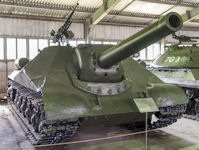ISU-152
In September 1943, when the tank KV-1S was filmed with weapons and in this connection interrupted the release of the SU-152, received the order of the GCO on the development of heavy self-propelled installation with a 152-mm gun-howitzer ML-20 on the basis of the new tank IS-1. Designers of Chelyabinsk Kirov plant under the direction of F. F. Petrova coped with the task during the month, and already to the new, 1944 the first 35 self-propelled SU-152 were sent to the front.
Compared to the previous 152-mm ACS the layout of the ISU-152 did not have significant differences. The Swinging part of the howitzer-cannon ML-20 was installed on a molded machine-frame and had a folding tray to facilitate the loading. The Mask of the gun was borrowed from the SU-152. The Reservation of the combat felling and hull in the frontal part has risen up to 90 mm. For Direct firing the telescopic sight was used, and for fire from closed positions the panorama of Hertz with independent or semi-independent line of sight was applied. The Maximum angle of elevation of the gun was 20 °, the horizontal firing sector-12 °. The self-propelled Ammunition of 20 separate loading rounds included fragmentation-and-armor-piercing-tracer shells.
Self-propelled units of the ISU-152 were part of the heavy self-propelled artillery regiments of the RGC and were attached to the advancing parts of the Red Army to destroy the firing points and enemy tanks. They were Particularly effective in storming well-fortified fortresses and defensive lines. For Example, on April 12, 1945, in the Battle of the Zemlandsky Peninsula, the battery of the 350 TSAAP hit 2 self-propelled units, broke 18 buildings and Bunkers with machine guns and destroyed about 90 enemy soldiers.
 The Object 704 was developed in 1945 on the basis of the IS-2 and IS-3 vehicles, under the supervision of Joseph Kotin. One of the distinctive features was the slope angle of armor plates. It passed trials successfully, but never entered service. In many ways it was superior to the ISU-152 with thicker and more well angled armour, without sacrificing much in terms of mobility which was comparable to the ISU-152. In some places, especially the mantlet, the armor thickness could reach 320mm making it the best protected Soviet Assault gun of the War. However, there were numerous issues that came with the tank. The gun lacked a muzzle brake. This noticeably increased the recoil of the gun. Combined with the sloped armor which reduced space in the fighting compartment, it significantly complicated the work for the crew.
The Object 704 was developed in 1945 on the basis of the IS-2 and IS-3 vehicles, under the supervision of Joseph Kotin. One of the distinctive features was the slope angle of armor plates. It passed trials successfully, but never entered service. In many ways it was superior to the ISU-152 with thicker and more well angled armour, without sacrificing much in terms of mobility which was comparable to the ISU-152. In some places, especially the mantlet, the armor thickness could reach 320mm making it the best protected Soviet Assault gun of the War. However, there were numerous issues that came with the tank. The gun lacked a muzzle brake. This noticeably increased the recoil of the gun. Combined with the sloped armor which reduced space in the fighting compartment, it significantly complicated the work for the crew.
Post-war changes were made to the final production run of ISU-152Ks by using the IS-2m chassis and the IS-3 engine deck. A total of 4075 ISU-152s were produced during the war, and a further 2450 manufactured between 1945 and 1955, when production ceased. After the end of the war, they were armed with the Soviet Army until the 1970s and were modernized twice. On the roof of the felling installed anti-aircraft machine gun DSHKM, ammunition gun increased to 30 shots, new equipment and observation devices night vision. A more powerful engine has received an ejector cooling system.
| Designation | ISU-152 |
| Type | Self-propelled assault gun |
| Armament | 152-mm howitzer-Cannon ML-20 |
| Crew, persons | 5 |
| Combat weight, T | 46 |
| Length, M | 9.05 in |
| Width, M | 3.07 in. |
| Height, M | 2.48 |
| Engine | B-2YS, Diesel, power 520 HP |
| Maximum speed, km/h | 35 |
| Range, km | 145 |
|
NEWSLETTER
|
| Join the GlobalSecurity.org mailing list |
|
|
|

